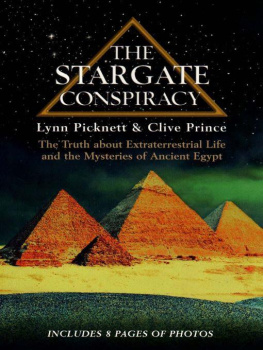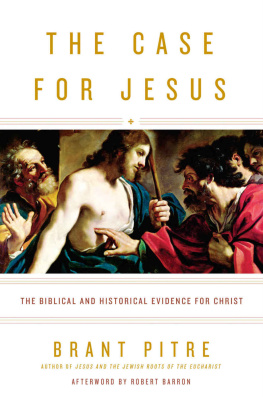T HE S TARGATE C ONSPIRACY: T HE T RUTH A BOUT E XTRATERRESTRIAL L IFE AND THE M YSTERIES OF A NCIENT E GYPT
T HE S ION R EVELATION: T HE T RUTH A BOUT THE G UARDIANS OF C HRISTS S ACRED B LOODLINE
ACKNOWLEDGMENTS
K eith Prince, as always, for his unstinting and enthusiastic help with our research, especially his insight into the parallels between the stories of Jesus and Nero.
Jeffrey Simmons, our agent and friend, who is always there for us.
The team at Simon & Schuster: our editor, Meghan Stevenson; Mark Gompertz; Chris Lloreda; Trish Todd; Ellen Silberman; Martha Schwartz; Rebecca Cox; Cherlynne Li; Alison Brennan; Kevin McCahill; Julie Adams; Michael Kwan; Megan Clancy, and Rachel Bostic.
For their unswerving help, encouragement, and friendship: Vida Adamoli; David Bell; Ashley Brown; Jenny Boll; Robert and Lyndsey Brydon; Deborah and Yvan Cartwright; Michele Cascarano; Bert de Wit; Carina Fearnley; Dr. Robert Feather; Stewart and Katia Ferris; Andrew Gough; William Kirchen; Vera Koutou; Sarah Litvinoff; Jane Lyle; Lisa Mead; John and Joy Millar; Charmaine Misson; Sally Morgan; Paul Nemeth; Craig and Rachel Oakley; Graham Phillips; Phyllis Pointer; Trevor Poots; Lily and David Prince; Francesca Prior; Nathan Renard; Rat Scabies; Javier Sierra; Mick Staley; Sheila and Eric Taylor; Mike Wallington; and Caroline Wise.
Thanks, too, to the staff of the British Library.
F or one of the most beloved and influential characters in history, Jesus Christ is curiously elusive. Our mission to discover the truth about the teacher from first-century Palestine who is still believed by millions the world over to be nothing less than God incarnate is seriously hindered by the paucity of reliable writings about him. Jesus himself left no written testimony, nor indeed did any of the primary eyewitnesses to his life and pivotal death. For such a uniquely significant individual, his life is strangely unrecorded.
There are writings that purport to be accurate accounts of Jesus lifethe most familiar being the four New Testament (or canonical) Gospels of Matthew, Mark, Luke, and John. But as they stand, they are a cacophony of different voices, as well as the result of later editing and accretions over the centuries. And although it is very likely that parts of contemporary records are embedded in those early texts, even beginning to peel off the layers of myth and sometimesit must be saidoutright propaganda that have accrued over two millennia is by no means a straightforward task.
Delving and Digging
There are not even any archaeological remains to compensate for the relative lack of written records. Unsurprisingly, modern Israel is a magnet for Christian tourism. What devotee of Christ would not want to walk in his footsteps by the Sea of Galilee or retrace the terrible journey through Jerusalem to Golgotha, the Place of the Skull, where he died on the cross? Yet of the many individual sites on the Christian tourist mapsuch as the Church of the Nativity in Bethlehem and the Church of the Holy Sepulchre in Jerusalemin all cases the link is merely traditional. Sadlyand to many Christians no doubt astonishinglythere is no hard evidence that any of these particular places was actually associated with Jesus. Every one of them is dubious, and most are provably bogus.
The problem with accepting any of these sites as genuine is that there was a huge displacement and discontinuity of population in that area between Jesus lifetime and the arrival of the first pilgrims in the fourth century, after Christianity became the official religion of the Roman Empire. When the Romans suppressed two great uprisings by the Jews, in 6670 CE and 13235 CE , whole towns and cities were depopulated either by massacres or enslavement. So did anyone really remember, three hundred years later, where these events had happenedor were the locals just trying to make a quick shekel out of the first Christian tourists?
Besides these dubious traditional sites, certain archaeological discoveries may relate directly to Jesus life, but none is proven beyond doubt and, even if they were, few would add substantially to the sum of our knowledge. For example, in the 1960s there were excavations in the area around the ancient synagogue in the town of Capernaum (modern Kefar Nahum) on the shore of the Sea of Galilee, where, according to three of the Gospels, Jesus first began preaching and where he recruited his first disciples. The archaeologists uncovered the foundations of several nearby houses from the same period that belonged to fishermen (hardly a revelation in a lakeside town). A Christian church had been built over one of them in the fifth century CE some four hundred years after Jesus time. Graffiti scratched into plaster indicated that the worshippers believed that the church stood on the site of the house of Peter, the disciple who, according to the New Testament, was closest to Jesus.
However, all this tells us is that four centuries after Peter lived, local Christians believed the house was his. Why they did so is unknown, so it is impossible to judge whether they were right. Capernaum had been utterly destroyed during the two Jewish revolts and since repopulated. The fifth-century Christians may have simply picked one house on the basis of accounts in the Gospels, which imply that Peters house was close to the synagogue.
Some of the most dramatic claims based on archaeological finds relate to ossuaries, the stone or clay boxes used by first-century Jews for the bones of their dead. Because of a shortage of space, they would place the shrouded corpses in a tomb for a year, until the flesh had rotted away, then store the bones in an ossuary laid in a family vault, usually a cave.
The late twentieth century saw several media sensations over claims that certain ossuaries had some direct or indirect connection with Jesus. Some were found by archaeologists; others surfaced in the antiquities trade. The latter are always treated with caution; solid evidence of their provenance is essential before they can be accepted as genuine.
Unsurprisingly, the most dramatic discoveries are those claimed to contain the bones of Jesus himself, since if genuine, they would not only provide hard evidence for his existence but also undermine the very reason he took such a hold on history. As he is supposed to have triumphed over death by rising from his tomb and, after making several appearances to his followers, to have been taken up bodily into heaven, the discovery of his entombed body would utterly destroy the religion founded in his name.
Several ossuaries have been discovered over the years that bear the inscribed name of Jesus (or Yeshua), and even of Jesus, son of Joseph. This is hardly surprising: depending on the survey, Jesus was either the third or sixth commonest male name, and as Joseph was the second most popular, to find a Joseph who named one of his sons Jesus is not very remarkable.
















